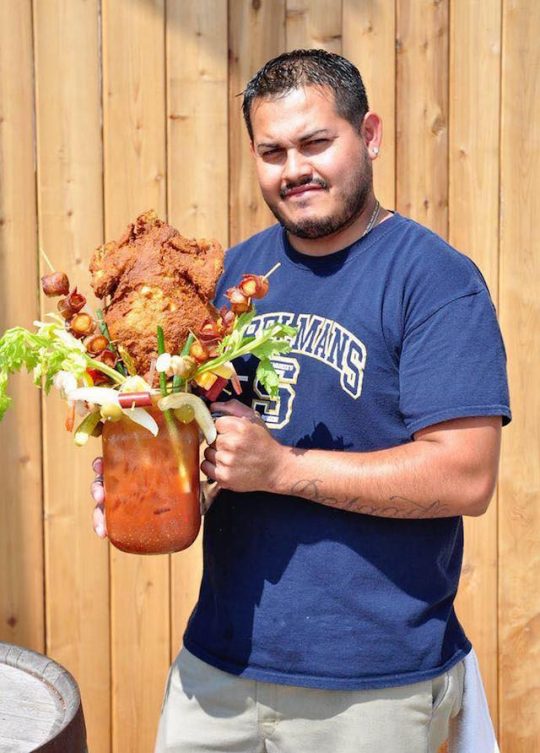The subject of today's A-hed in the Wall Street Journal is the Bloody Mary garnish boom—and I'm not talking about four olives instead of three. Writer Thomas Vinceguerra describes the Bloody Mary from Party Fowl, a restaurant in Nashville, as "weighing 7½ pounds and requires some muscling. Its garnishes extend about 7 inches up from the rim and 4 inches to the side. They include fried okra, an avocado, baseball-size Scotch eggs—and two Cornish game hens on 12-inch skewers." Which is nothing compared with the garnishes atop the Chicken-Fried Bloody Beast from Sobelman's Pub and Grill in Milwaukee: Lemon, celery stalk, Brussel sprouts, asparagus, onion, scallion, mushroom, shrimp, cheese, pickle, bacon-wrapped jalapeño cheeseballs, and a whole fried chicken. A 70-ounce plastic pitcher supports this large libation.
But what's in the pitcher itself? I am reminded of a conversation I once had with the late Michel Richard about the Food Network show Ace of Cakes. I told the French chef that host Duff Goldman made the most amazing-looking Millennium Falcon. "But how does it taste?" he asked. Similarly the importance of the Bloody Mary mix seems to have been lost amid this onslaught of toppings.
"As always, I question the wisdom of putting food into cocktails," says Derek Brown, a drinks historian and mixologist who owns several bars in Washington, D.C. "Whenever people are seeking substantial nourishment from alcohol I wonder if a few meetings and some time with a higher power are in order. Drinks are there to drink. And, yes, I know they can straddle the line. We've used porcini tincture too. But I'm talking about your dinner resting on the edge of your glass. If it does, please seek help."
Such was not the case in 1934, when Fernand Petiot concocted the first Bloody Mary for customer Serge Obolensky at Manhattan's King Cole Bar. Back then, the drink included vodka, tomato juice, salt, pepper, Worcestershire sauce, lemon juice, cayenne pepper, and an olive garnish—as in one olive. Other garnishes were added along the way, mostly of the pickled variety. But now it seems the toppings have surpassed the drink in importance. We are eating a meal first. Drinking becomes an afterthought.
Not that any of this should come as a surprise. The flavored vodka trend (already on a downward slope) was about drinks imitating food: Think of Pinnacle Vodka varieties like Cake and Salted Caramel or Van Gogh's PB&J. The Bloody Mary is now about the food—sliders, fried chicken, sausage, and more. The trend is also reminiscent of the Burger Wars of the early 2000s. It began with Daniel Boulud's DB Burger, involving braised short ribs, foie gras, and shaved Périgord black truffle. The Old Homestead Steakhouse fired back with a burger made of Japanese Kobe beef. Then came the Wall Street Burger Shoppe's $175 hamburger with foie gras, truffle, and gold leaf flakes (you can tell this was made before the fall of 2008).
Then the emphasis reverted to the burger itself—what's in the beef? I imagine the same will one day happen with the Bloody Mary. The focus will be about the basics (bartending legend Gary Regan prefers to add a bit of horseradish, which does wonders). In the meantime, expect more burgers atop your 70-ounce plastic pitcher of Bloody Mary. On the bright side, the burgers will probably be grassfed and hormone-free.
